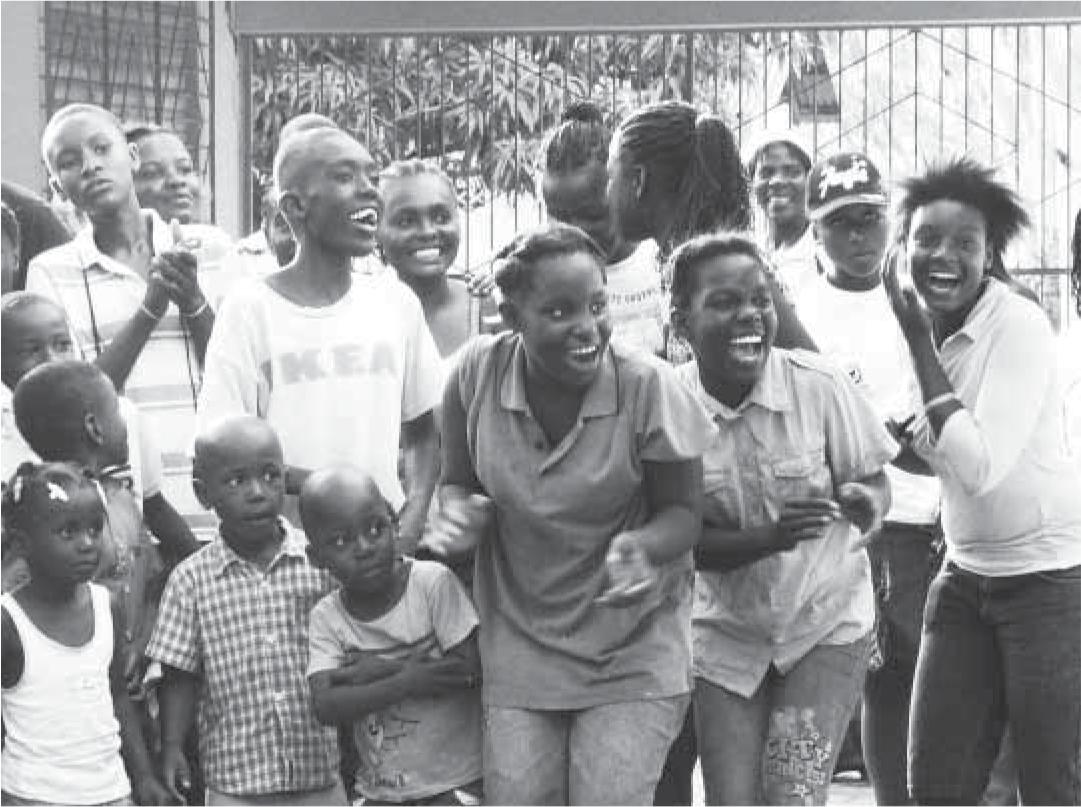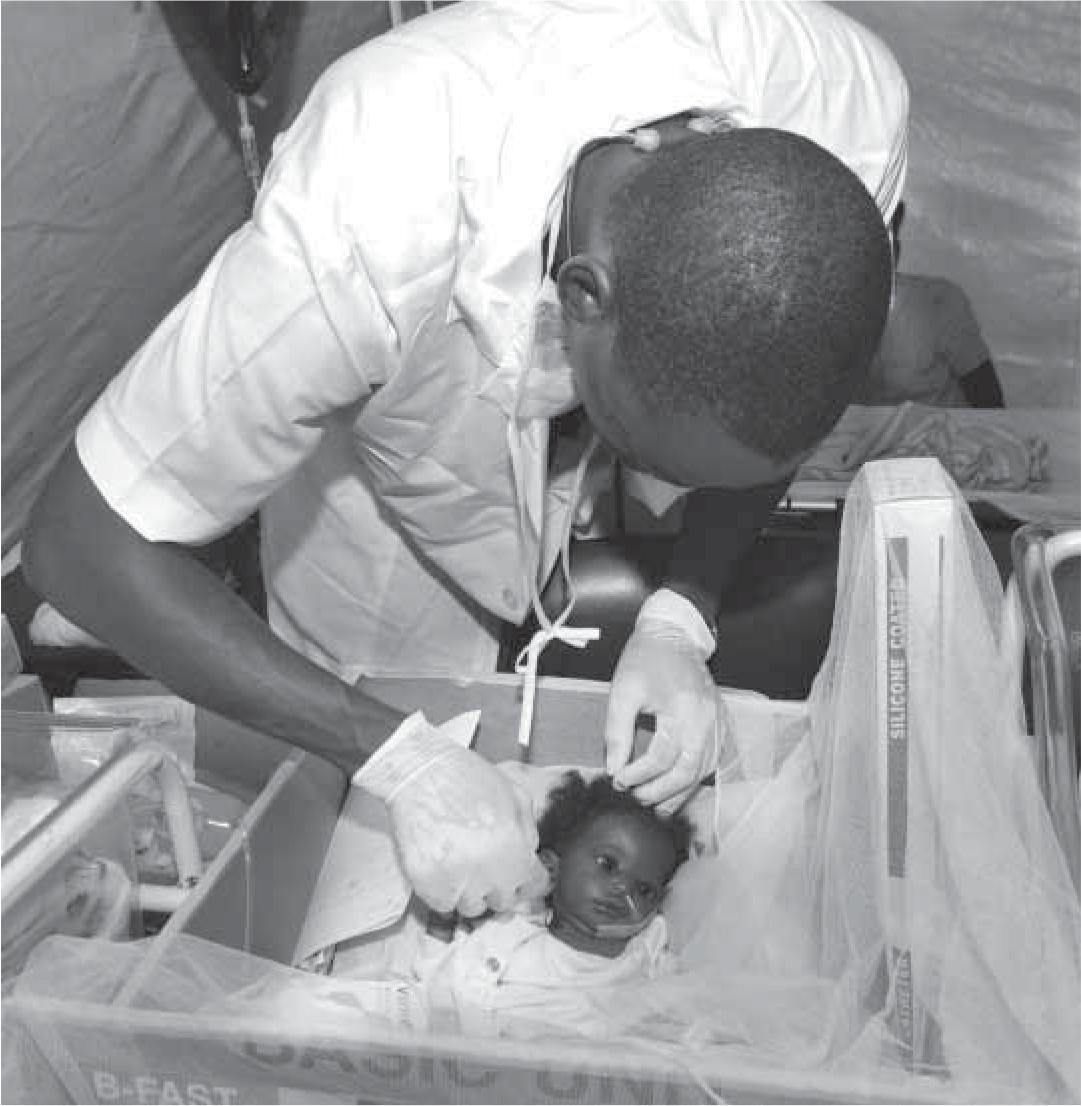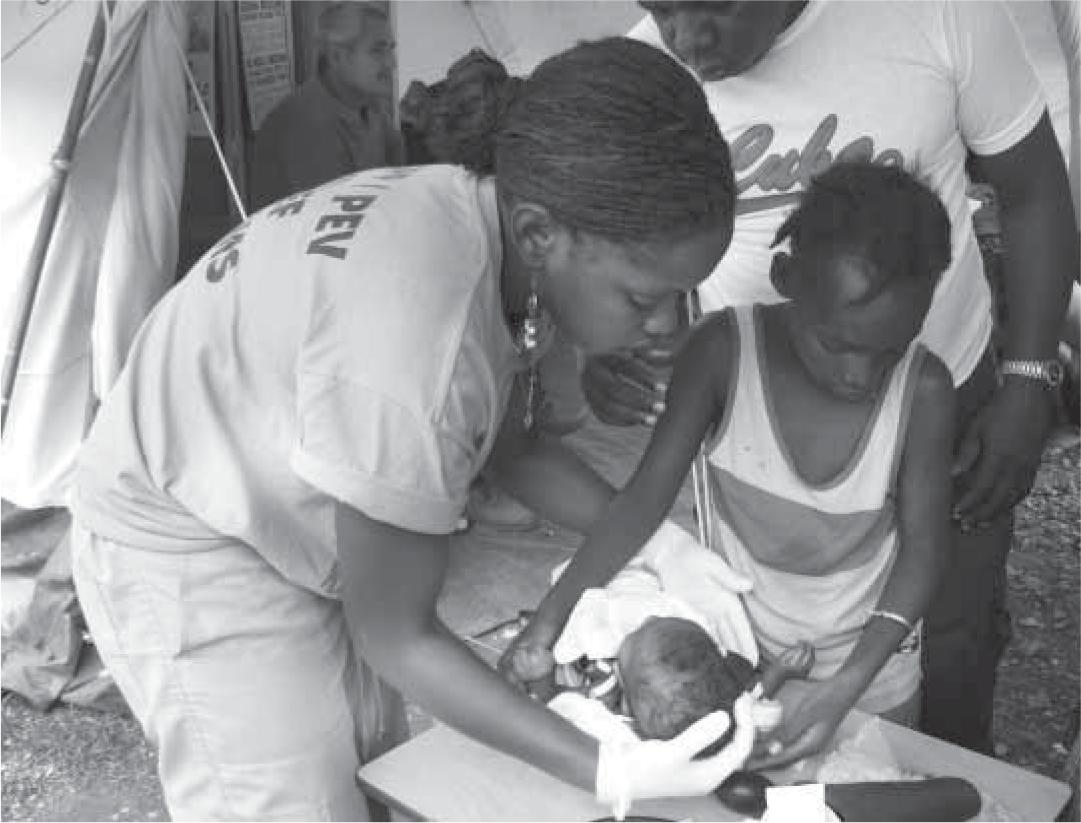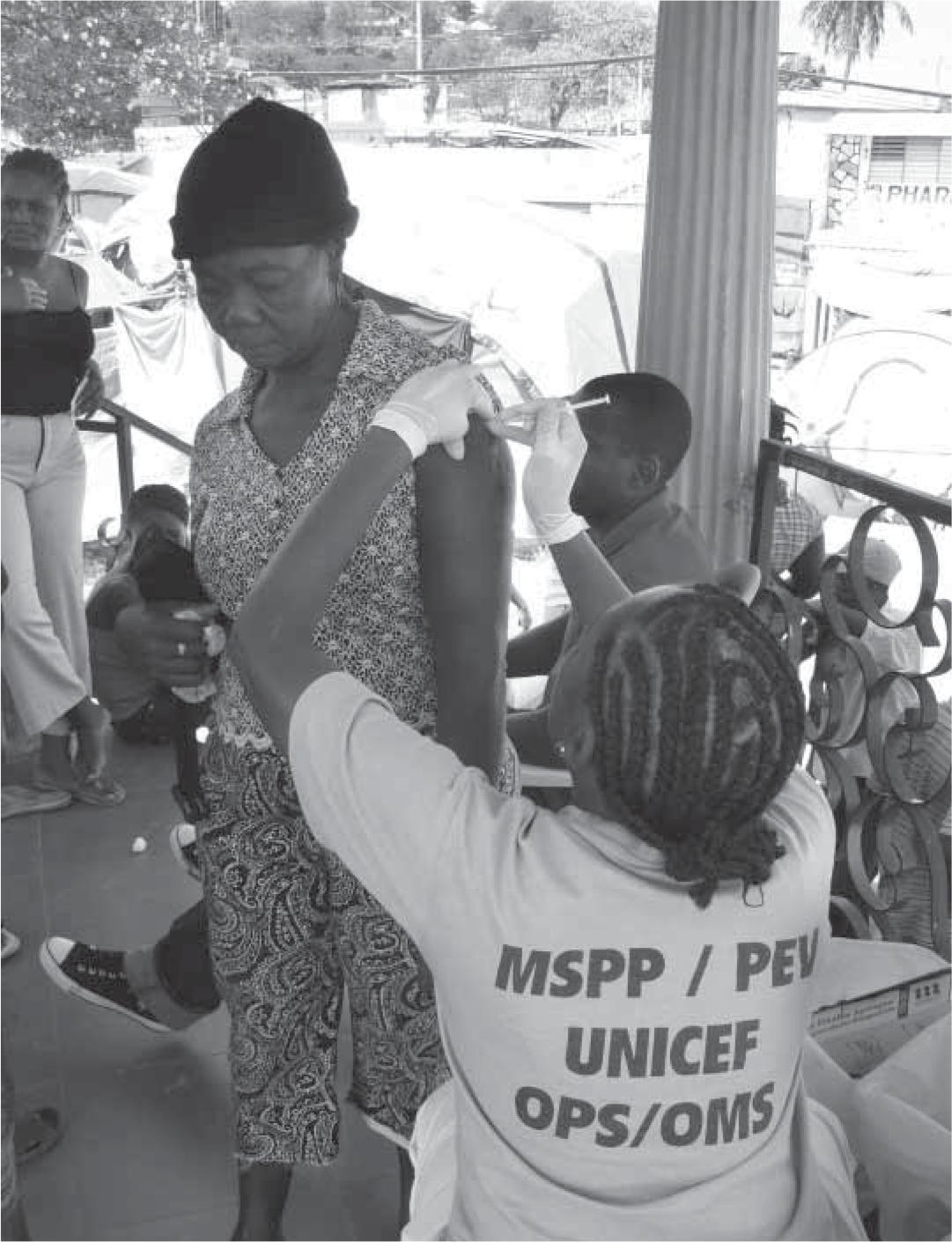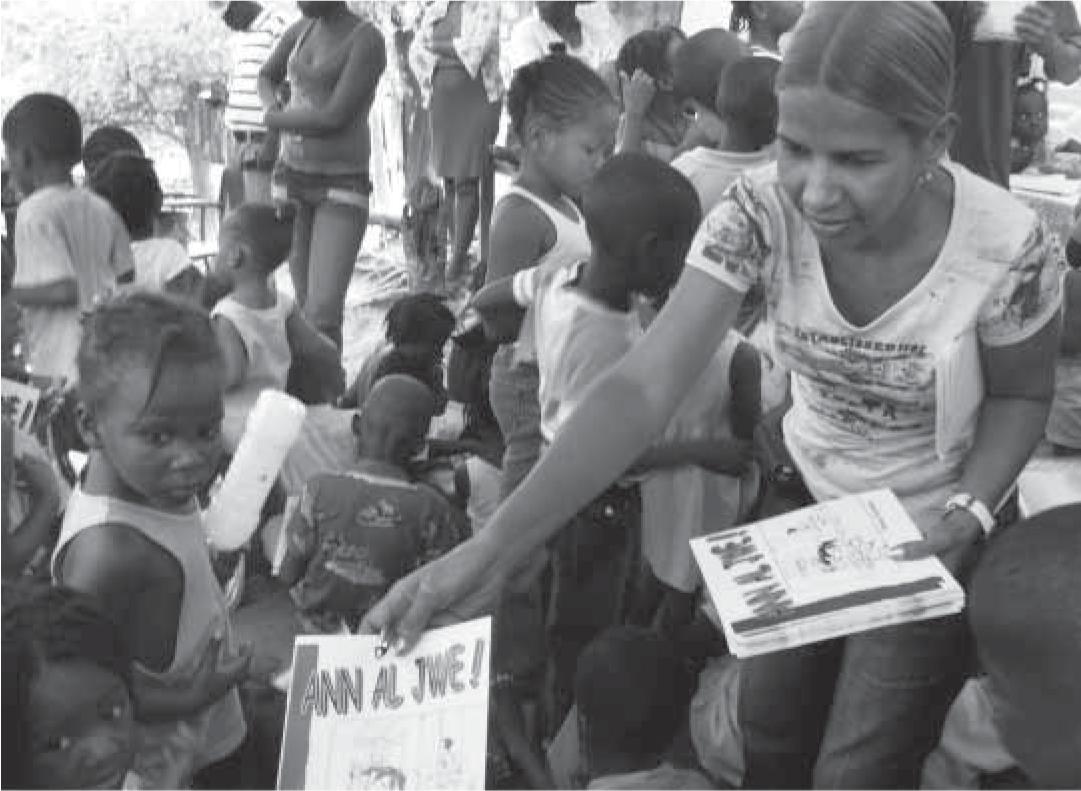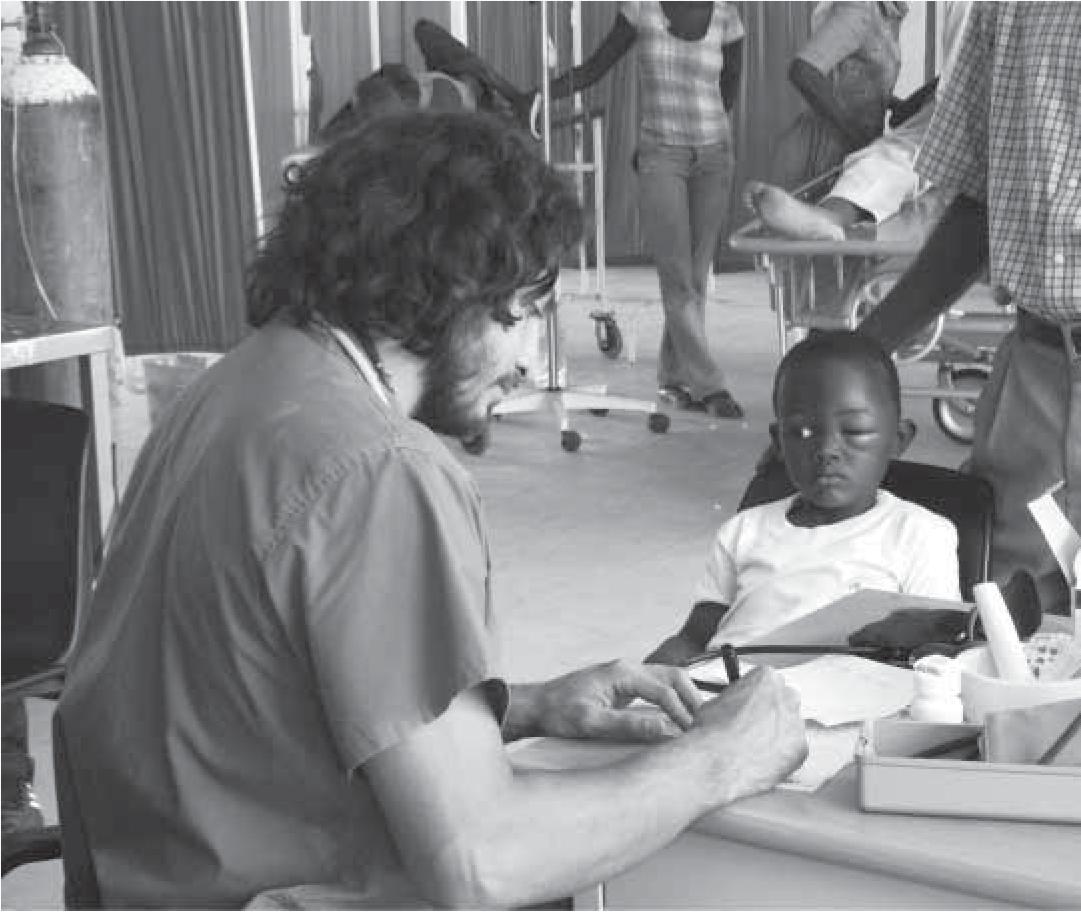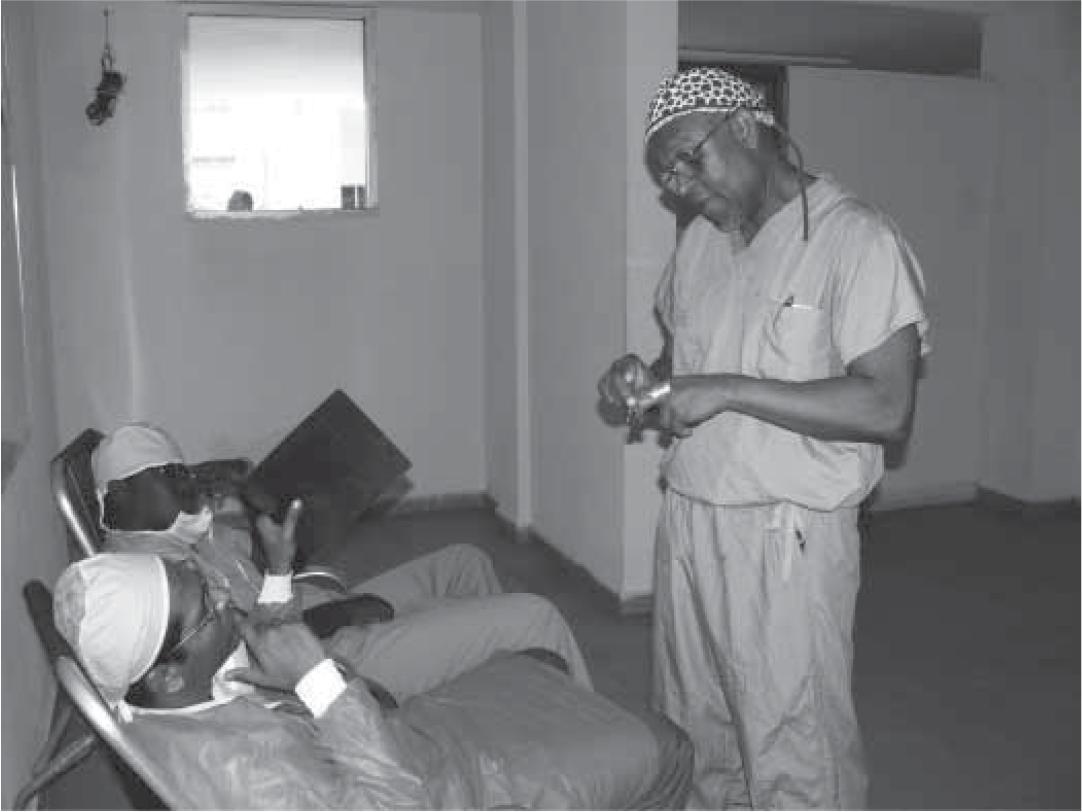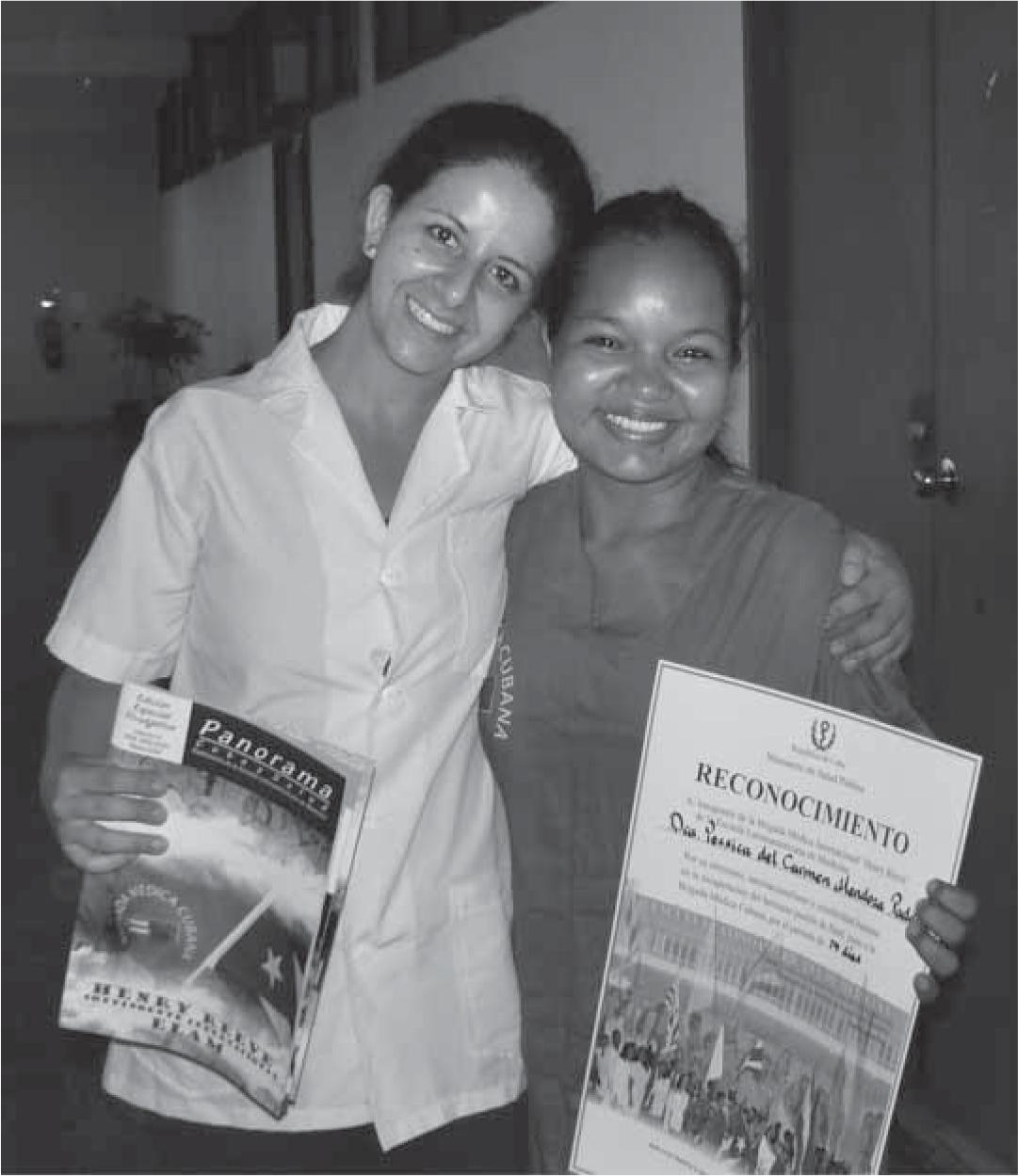Abstract
Haiti is a country that appears fleetingly in the English-speaking media, when stricken by disaster or more recently by epithets. Perhaps few are aware that Haiti was the first independent nation in Latin America and the Caribbean, and the world’s first black republic—independence declared on January 1, 1804—in a revolution led by former slaves who defeated Napoleon’s 40,000-strong colonial forces. Or that, when others abandoned the independence wars against Spain, Simón Bolívar appealed to Haitian president Alexandre Pétion and with Pétión’s troops and material aid, went on to free slaves across Spanish-held colonies in Latin America.
Over the centuries, the Haitian people have indeed been beset by disasters, both natural and man-made. But they have also stood against daunting odds and have received solidarity from their hemispheric neighbors, Cuba among the countries allied with Haiti’s attempts to provide for its people.
In this Retrospective, MEDICC Review reprints excerpts from a blog by Senior Editor Conner Gorry, who, during February and March 2010, was embedded in the disaster-response medical team sent from Cuba after the January 12 earth-quake. The team reinforced nearly 500 Cuban health per-sonnel already on the ground long term in 120 communities. Some 700 of the 1300 new arrivals were students or graduates of Cuba’s Latin American School of Medicine from 27 countries. Haitian graduates now number 1044. The international contingent (named after Henry Reeve, a Brooklyn-born general in Cuba’s own independence struggle)—became the largest medical relief effort assembled after the quake.
The vivid stories here take us back to the urgency and chaos of those first weeks and months after disaster struck. But Haitian, Cuban and other Cuban-trained doctors dedicated to Haiti’s recovery—its long-term health care needs and strengthened public health system—provide an example of commitment to social equity and human solidarity in the face of enormous challenges. And their work with those from other countries proves effective cross-border, cross-cultural collaboration can work.
Today, there are 664 Cuban health professionals collabo-rating in Haiti, 175 of them doctors posted throughout the country. In 2017 alone, they carried out 2.64 million patient consults, performed 40,842 surgeries, and delivered 5788 babies (many times working with local midwives). They labor in 21 community reference hospitals built with funds from Venezuela; 31 rehabilitation centers, also built after the 2010 earthquake; 14 health centers; and 29 sentinel sites for epidemiological surveillance (mainly for cholera and vector-borne diseases). A national workshop for orthotics and prosthetics was also established to assist earthquake victims, with equipment and other resources provided by Cuba.
The Editors
“[There] were 480… Cuban health professionals in Haiti at the time of the earthquake. After the earthquake Cuba sent 1300 new … additional health professionals … Most of them … are in the province[s] and they are absolutely important for the country. Absolutely.”
—Dr Henriette Chamouillet, WHO/PAHO Representative in Haiti, 2010
A Day at the Leogâne Field Hospital
Leaving Port-au-Prince is an exercise in self-defense: the assault of sights, sounds, smells and emotions requires closing your eyes, covering your nose, and shielding your heart from Haiti’s brutal realities.
Haitian drivers—jumping dividers on their motorcycles into oncoming traffic or taking blind curves at high speed in colorful, emblematic taptaps—are additional hazards. On the map, Leogâne is only 20 miles west of Port-au-Prince, but pedestrian congestion and car traffic combine with the earthquake-buckled road to make it an hour-long trip. The city of 16,000 isn’t far from the epicenter, and according to some estimates, 90% of the homes here were damaged in the quake. The widespread destruction caused by the disaster, compounded by the prequake health picture has manifested in a wide array of health problems, making it a logical location for a Henry Reeve Emergency Medical Contingent field hospital.
Staffed by Cuban doctors and graduates of Havana’s Latin American Medical School (ELAM) from eight countries, plus five Haitian ELAM students who serve as translators and health promoters, the hospital in Leogâne offers free pediatric, ob-gyn, internal medicine and other services in individual tents divided by specialty; the most serious cases are referred to the hospital in nearby Saint Croix, while others are admitted to the limited-capacity tent wards on site.
“We had to adjust our strategy to reach more people,” says Dr Wilbert Barral from Potosí, Bolivia (ELAM 2007) who heads the ELAM component of the Leogâne team. “Many Haitians haven’t seen a doctor before or aren’t sure how our services work. They think we may charge them, for instance, so we began going into the communities to provide consultations and tell people about the field hospital, explain the services, and that they’re free.” With this new strategy, the previous daily average of 500 patient visits has increased to 800. Dr Barral told me that pregnant women and children are the priority since they are the ones at highest risk in post-disaster situations.
Patients with chronic diseases are also a priority. “We’re seeing a lot of hyperthyroidism, but not one case of leptospirosis, which is surprising since it’s endemic in Haiti,” explained Dr María Esther from Nicaragua (ELAM 2005).
The doctors at Leogâne emphasize that the emergency health phase has passed: The challenge now is to provide public health services that emphasize disease prevention and health promotion, including vaccination campaigns.
… Today, the Leogâne hospital was full of song and dance, thanks to the voices, drums and infectious energy of Agrupación Vocal Desandann, a musical group of Cubans of Haitian descent. Hailing from Cuba’s Camagüey province, the group is part of the Henry Reeve’s mental health project, and came to Leogâne to sing traditional Creole songs, accompanied by dancing and lots of audience participation. The group first visited Haiti in 1996 and has been back over half a dozen times since to perform and deepen their ties with their ancestral roots. Many members speak Creole, including Director Amelia Díaz and composer Marcel Andrés whose 50th birthday is today. Slowly but surely, as the melodic strains came floating over the camp, community members began gathering. Before long, children were clapping, teens were dancing, and a terribly shy grandmother broke into a gap-toothed, ear-to-ear grin. March 4th is the 16th anniversary of Agrupación Vocal Desandann, and what a way to celebrate—in Haiti, bringing smiles and laughter to Haitians.
From Emergency to Building Health: Hundreds of Cuban-Trained MDs Posted Throughout Haiti
The commitment to Haitian health care made by graduates of ELAM after the earthquake entered a second phase today as more than 250 doctors fanned out to take up their new posts at health centers and hospitals around the country.
These Cuban-trained doctors—joining the Cuban medical teams in Haiti—hail from over 25 countries in Africa, North and South America, the Middle East and Asia. And, of course Haiti itself.
The new assignments for these ELAM grads mark the formal transition from the emergency medical phase of the Cuban-led effort—addressing immediate problems such as wounds, burns and acute respiratory infections—to the next, more sustainable phase of providing long-term health care. The young doctors are being folded into Cuban health teams that have been working in the Haitian public health system without interruption since 1998.
Each ELAM doctor has chosen to stay in Haiti from three months to a year. “I’ve committed to six months, but I really want to stay a year,” says Dr Sindy Gómez from El Salvador (ELAM 2008), “After that,” she told me, “I’ll discuss with my husband the possibility of staying longer. The Haitian people need us.” ELAM doctors from Colombia, Panama and Brazil echoed Dr Gómez’s sentiments—all the more noteworthy, since many of these young physicians come from low-income families that depend on them.
“All of them were motivated and willing to stay,” said Eladio Balcarcel, Cuban coordinator of the ELAM graduates in Haiti. “Some are now going to more remote communities, but the conditions will be better. Living in tent camps for a couple of months is tolerable, but it’s not sustainable over the long term,” he explained in the midst of the sendoff. In their new posts, the doctors will be living in houses with electricity and water, and working in health centers and hospitals providing primary care services.
One of the 170,000+ “Cases”
I do a lot of listening here, asking far fewer questions than I usually would, and I never inquire about family…
There’s a light drizzle falling as the busload of doctors, nurses, and fifth-year medical students head out for the morning’s work in the Cuban health posts known as Belair I and Belair II. Stuttering through the clogged, rubble-strewn streets of Port-au-Prince, the bus is a veritable United Nations of medical personnel: there are Cuban doctors of course, but also Colombian, Brazilian and Panamanian physicians, plus Cuban nurses and Haitian MDs and students from ELAM—all trained in Cuba. Ironically, as we inch past elders selling charcoal from reed baskets and young toughs peddling black market antibiotics, an armored vehicle full of UN blue bonnets chugs past.
Belair I and Belair II are misnomers—these are not pretty places and the air is anything but. The camps are sprawling, muddy settlements with shelters made from plastic sheets and sticks, cardboard and corrugated metal packed cheek by jowl. Small children, barefoot and bare-bottomed often, beautiful and innocent always, suck their thumbs and watch as we walk past. In the middle of this stark reality stand the health posts: simple tents with a couple of rough-hewn benches and chairs where patients wait to be seen and treated for free by the Henry Reeve Emergency Medical Contingent.
“We were told this was a very rough area, with a lot of crime, when we learned where we would be working,” said Arnaldo Santa Cruz, a physical therapist from Havana. But with over six weeks in operation, the Cubans are respected and protected by Belair’s community. Today, like every day, women with babies and their young children, grandmothers and the odd man, wait patiently to see one of the “Cuban doctors” as the entire group is known. At the end of a long morning diagnosing and treating acute respiratory infections, scabies, and other common conditions plaguing Port-au-Prince’s population, a young girl arrives with a too-small bundle swaddled in a towel.
The girl is eight, her baby brother, the swaddled bundle, is just four months old. Dr Yahimely Pezcalderón, a family doctor from Cuba’s Cienfuegos Province, lays the infant gently on the table. He’s clearly malnourished and is running a fever of 103°. With Jude Celerin, a fifth-year Haitian ELAM student translating, Dr Pezcalderón learns that this eight-year-old girl has been taking care of her baby brother and little sister since the earthquake. Their mother is in the hospital and the prognosis isn’t good. Dr Pezcalderón prescribes the medicines the baby needs to control the fever, but she is doubtful. “I don’t like seeing children come to the health posts alone. They usually don’t read and it’s hard for them to understand the dosage and how to take the medicine. I’ll make sure they come back tomorrow and follow up, but …” We haven’t seen them since, but it has been raining, and patients typically stay away in the rain.
An Ounce of Prevention: Port-au-Prince Vaccination Campaign
“At the beginning, we were vaccinating around 250 people a day, but it’s tapered off to 70 or so,” Raysoly Yacob Flores, a Salvadoran nurse trained in Cuba, tells me as we set out for the displaced persons camp where the Henry Reeve Contingent will vaccinate all comers. I’ll admit I’m slightly disappointed that I’m catching the tail end of the action. I’ve heard a lot about the massive vaccinations carried out by the Cubans and their ELAM-trained colleagues in the weeks immediately following the earthquake, when multiple teams fanned out through the sprawling encampments that hundreds of thousands of Haitians now call “home.”
But my disappointment is premature: instead of tagging along with Raysoly or the other team to areas where vaccinations have already been initiated, I’m accompanying Cuban nurse (and head of the Port-au-Prince vaccination effort) Esmeris Atinol to a camp where no one has yet been vaccinated. It should be interesting to watch the team inaugurate a new location. A recent report filed on the blog Haiti: Operational Biosurveillance by Dr James Wilson describes health actions, including vaccinations, at a displaced persons camp in Pétion-Ville: “when word spread about sore arms and the occasional post-vaccination fever, very few showed up for the second day of vaccinations. Red Cross left the area, leaving a best estimate of only 20% of the population vaccinated.” Given the limited experience many Haitians have with health care in general and vaccinations specifically, I’m especially anxious to see the community’s reaction to this basic preventive health measure.
Delmas 15 (as it’s called by the Cubans) is formally known as La Place Dame Carrefour Aéroport in the post-quake language of Port-au-Prince. It’s a postage stamp plaza at the city’s major intersection of Rte de Delmas and Blvd Toussaint Louverture where 1060 people live in donated tents pitched on bare, blazing hot concrete.
Before we’re even beyond the first line of dust-covered tents, nurse Esmeris is chatting up mothers in lyrical Creole, asking if they’ve been vaccinated. Though she hails from the remote Cuban municipality of Tercer Frente in Santiago de Cuba, Esmeris’ forbearers were Haitian and she has been working in Haiti as part of Cuba’s Comprehensive Health Program for the past year. She traverses the divide between Spanish and Creole easily and I can see the relief etched on the mothers’ faces as they converse in their native language. They follow this Cuban nurse to the vaccination post eagerly, small children in tow.
“Post” is an exaggeration. Each time the Henry Reeve Contingent initiates vaccinations in a new location, they have to find an accessible (and hopefully shady/rain-proof) location to set up. Luckily, La Place Dame is anchored by a pastel-colored gazebo that overlooks the fenced-in camp. The columns are cracked and crumbling from the quake, the rebar laid bare like an open wound, but no matter: its visibility and staircases at either end provide natural patient flow, plus it’s refreshingly sun-free. From nowhere, a pair of clean-cut youths, badges of the camp’s organizing committee dangling from their necks, appear carrying two chairs—each with three legs. Seems everything in Haiti these days is a balancing act. Once a table materializes (again I’m amazed at Haitian solidarity—that people so destitute and physically and emotionally battered still have the energy to share both among themselves and with us), the team is set to go to work.
The Henry Reeve Emergency Medical Contingent currently offers three vaccines: a trivalent DPT (diphtheria, pertussis and tetanus) for babies one-and-a-half months to eight months old; a DPT/measles/rubella combination, paired with vitamin A for children nine months to seven years old; and a diphtheria— tetanus duo for everyone eight and over. Once again, the supplies used by the Cuban team represent a kaleidoscope of international health cooperation with vaccines from India, Canada and the WHO Essential Medicines Program; disposable syringes from the United Arab Emirates; and nifty collapsible biohazard safety boxes from Finland.
Conducting an effective vaccination campaign in conditions like those in post-quake Haiti is extraordinarily complex. There are issues related to the vaccines themselves (primarily the maintenance of the cold chain and safe disposal of hazardous biowaste), but also to the particular health culture and context of the host country. And Haiti is as intricate and layered as they come. Fortunately, scores of Cuban health professionals— doctors, nurses, specialists and technicians—in Port-au-Prince have been serving in Haiti for a year or more as part of Cuba’s Comprehensive Health Program. Veterans on these shores, they exhibit a rare affinity for this strikingly different culture. Importantly, nurse Esmeris and several of her colleagues working on the capital’s vaccination campaign were posted in Gonaïves before the earthquake. There, they vaccinated over 40,000 people between October and January 12, meeting the country’s obligation made to PAHO as part of the national immunization program.
Given all this back story, I shouldn’t be surprised when the trickle of people to be vaccinated turns into a stream and eventually a torrent of the Place de Dame community. A teacher lines up her grade-school class for the free vaccines (school still hasn’t started, but this camp is well organized, with young people especially assuming whatever responsibilities required, like this teacher caring for her out-of-school students), and there are grannies and well-dressed men too—even the camp tough guys are rolling up their sleeves, anticipating the jab with a squint and a smile.
But it’s Elvire Constant who really ratchets up the work flow. Once she happens on the scene, people start arriving in droves, from other camps and the street even, belying Raysoly’s 70-or- so prediction. A strong, wiry woman with the intricate braids favored by many Haitian women, Elvire is president of the organizing committee of a nearby camp where the Cuban teams previously worked. “Thanks to her, we vaccinated that entire camp,” Esmeris tells me. I can see why there has been such great acceptance: Elvire arrives, picks up a bullhorn, presses ‘talk’ and begins singing in a lovely, lilting Creole about the ‘free vaccinations, available here all morning, given by Cuban doctors.’ She threads her way between tents and out to the street calling on vendors, office workers and passersby to get vaccinated, like some muezzin of better health.
Each person receives a yellow vaccination card with the seal of the Haitian Ministry of Public Health, indicating their name, age, and vaccine administered (and schedule of additional shots in the case of DPT). Everything is in Creole and explained by the Cubans with the help of Haitian volunteers who lend a hand wherever the medical teams are found. Today, Jackson Pierre Louis and Gladimir Alexime, members of the Place de Dame camp organizing committee, appear unsolicited to help fill out the yellow cards and explain the procedure.
Given the language barrier and the novelty of the vaccination concept (several people from Place de Dame line up for a second vaccination for example), I ask Esmeris how the program is administered. “We keep detailed records of where we’ve been and how many people of each age group we’ve vaccinated. In two months’ time, we’ll revisit each area to administer second doses for those requiring them. After that the Haitian health system provides the booster shots.” I raise an eyebrow at this last part, given that the public health system is in such disarray. She tells me that’s the ideal. Still, there is hope: the Haitian government and the Bolivarian Alliance for the People of the Americas (ALBA) presented a plan for reconstructing the Haitian health system to the WHO last week. In today’s Haiti, it’s imperative that such ideals get translated into realities.
In the meantime, the work of the Cuban teams takes on increasing urgency as the rainy season approaches, says Dr Jorge Pérez, Director of the hospital at the Pedro Kouri Tropical Medicine Institute, Cuba’s reference center for infectious diseases. In Haiti to conduct an epidemiological assessment, Dr Pérez told me vaccination, health promotion and prevention are the most important tasks right now. “It’s important to be vigilant. The epidemiological picture is going to get much more complicated when the rains come.”
With this in mind, Cuban health professionals, accompanied by graduates of ELAM and innumerable Haitian volunteers, continue their massive vaccination efforts in post-quake Haiti. And Raysoly’s estimate? That day in Place de Dame, the Cuban team vaccinated over 400 people. And the folks keep on coming: Esmeris just visited my tent to report that they broke a record in another camp where the teams are working. “We vaccinated over 500 people in Delmas 83 today. We worked from 9 to 2 and had to ask people to come back tomorrow.”
Love, Laughter & Art in Post-Quake Haiti
“Where there’s love, there’s life,” said Gandhi, and Port-au-Prince has been overflowing with both since the arrival of the Martha Machado Artists’ Brigade here. The brainchild of Cuban artist Alexis Leyva Machado (Kcho—pronounced KAHcho) the artists’ group aims to alleviate the psychological and emotional effects of natural disasters. Watching children’s beaming smiles and hearing squeals of delight peal from teens and adults alike as the group performs, I’d say it’s working.
Founded after a trio of hurricanes hit Cuba in 2008 causing $10 billion in damages, the Brigade features a rotating roster of painters, musicians, magicians, clowns, puppeteers and circus performers.
Fifty of these Cuban artists are now in Haiti to help heal through laughter, dance, art and play; many are veterans of the original Brigade that visited the Cuban regions hardest hit by the 2008 hurricanes. One of those was the Isle of Youth Special Municipality, from where Kcho hails. The Brigade is named after the artist’s mother who gave shelter to family, friends and neighbors affected by the storms.
The healing properties of laughter and play are well documented and serve particularly well for children in post-disaster situations. Young survivors are often unable to express the resulting trauma verbally, complicating mental health diagnoses and the work of health care professionals. For this reason, the Martha Machado Brigade is formally a part of Cuba’s post-disaster mental health program in Haiti, coordinated by psychologist Alexis Lorenzo of the Latin American Center for Disaster Medicine (CLAMED) in Havana. “Much of what we’re seeing are normal reactions to abnormal circumstances,” he told me, including anxiety, fear, stress and sadness—a trio that gets blown to the four cardinal points when people become engaged with the Cuban artists in their midst.
“The situation is so sad here, but you can feel the energy shift when the Brigade shows up. The kids enter a new world,” artist Ernesto Rancaño told me as we watched an event unfold at the Hôpital Renaissance. A magic trick deftly executed; stilt walkers rocking babies, and clowns kidding teens; a Cuban artist and Haitian child painting side by side—these are the building blocks of happier memories for Haitians traumatized by the January earthquake. The more the children can express their feelings the better, according to psychologists, since drawing and other types of creativity help them gain symbolic control over confusing and frightening events.
One of Cuba’s most talented contemporary painters and original member of the group in Cuba, Rancaño and several other painters supplied all the materials for the post-hurricane work in Cuba, creating alongside Cuban children affected by the storms. This experience is being replicated in Haiti; the resulting works of art by Haitian children, together with over a dozen paintings by Cuban children brought by the Brigade for this purpose, will be installed in public hospitals in Haiti. Twenty-five works of art by Kcho, Rancaño, Sander Gonzales and Juan Carlos Balseiro will likewise be permanently installed in Haitian hospitals. All told, the collection comprises over 150 works of art.
“This goes beyond Cuba, beyond Haiti. Our mission is to bring smiles and hope to people who have suffered natural disasters. The healing power of art and laughter is universal, and this is what our Brigade tries to do,” said Kcho later at an event at the Cuban field hospital in Carrefour, west of Port-au-Prince. The group of artists has pledged to stay as long as necessary.
Still made up as clown and musician, Ronny Fernández from Havana told me why he joined the team in Haiti: “It’s beautiful to be able to use our skills to take these people away from the catastrophe, if only for a moment…. We’re living in tents and conditions can be tough, but the smiles on the kids’ faces— that’s plenty compensation.”
Combining caring and science is part of psychologist Díaz’s work, including a methodological framework for addressing disaster-related mental health disorders. As coordinator of CLAMED’s master’s degree program in mental health and disasters, Díaz is accompanied in Haiti by the two-year program’s first graduate. Also in Haiti to address the mental health needs of earthquake survivors are four psychologists, 12 child psychiatrists and 7 general psychiatrists.
Psychologist Mariela Almenares is among these Cuban volunteers working with Haitian children and teens who survived the quake. In an initiative launched on March 17, Mariela leads a team comprised of Argentine and Haitian doctors and fifth-year students trained at ELAM. They are providing integrated medical and psychological services to several orphanages in Port-au-Prince, where the Artists’ Brigade also performs. All agree this is one of their hardest assignments. “Yet, ten years down the line, hopefully these kids will remember today and have at least this one good memory from this terrible tragedy,” Rancaño told me. I’m betting he’s right.
Making the Rounds: Hôpital Universitaire de la Paix
It’s not even 7:30 and already it’s hot and close as we board the bus for the circuitous, rubble-pocked ride to Hôpital Universitaire de la Paix. As the crow flies, it’s probably less than a mile from our tent camp to Port-au-Prince’s university teaching hospital, but weaving between vendors and tents pitched in the street, and then caught behind a tractor or backhoe, means it takes almost an hour to get to the front gate.
I’m traveling with the Cuban medical team that will staff the ER for the next 24 hours, relieving other members of the Henry Reeve Contingent. My fellow passengers include nurses, lab technicians, family physicians and a few other specialists, like Dr Douglas Valverde, an energetic orthopedic surgical resident who received his training at ELAM. Costa Rican by birth, Dr Valverde is one of the more than 700 ELAM-trained health professionals, including young Haitian MDs, in the Cuban-led international team.
Haitians of all ages are waiting their turn at medical tents pitched in the courtyard when we arrive. Things are fairly well organized, which is a dramatic improvement over the situation in the days following January 12. Hôpital Universitaire de la Paix was at or near capacity when the earthquake struck; it was quickly overwhelmed as the tremors subsided and new patients made their way in droves to the facility.
“The courtyard was filled with wounded people. To cross it we had to step over and around them saying ‘excuse me, excuse me, excuse me’ the whole time,” Dr Wilson Canton, a Haitian graduate of the ELAM told me. “The building was in decent condition, but there was no light and no water. We delivered babies using the lights on our cell phones. There were patients everywhere,” he tells me in that stoic, but compassionate way Haitians have. This image of the aftermath settles over our conversation.
In the Post-Op, Post Quake
I’m sure what I’ll see today at Hôpital de la Paix won’t compare to those first days and even weeks after the earthquake. Still, coming into the postoperative ward where orthopedic resident Dr Valverde and Cuban colleagues Dr Mariela Rodriguez and Dr Rafael Roque visit with patients, I’m rocked back on my heels.
The heat in the 14-bed unit hovers over amputees of all ages, some moaning in what I imagine is pain mixed with frustration (and undoubtedly fear). This guttural chorus is joined by a clutch of women in the center of the room chanting and undulating, lost in energetic prayer. Daughters, girlfriends, nephews and neighbors wave kerchiefs and swaths of cardboard over their loved ones to keep the flies away. A piercing odor of human waste permeates the scene as an older woman, both legs cut off at the knee, talks to herself in a loud, stricken voice.
The first bed is occupied by one of Dr Valverde’s patients: a beautiful 18-year old who was hit by a car several days ago and presented with a broken femur. Although some of the 84 members of the Henry Reeve team working at this hospital speak Creole, Dr Valverde enlists translating help from one of the women who comes to pray for patients in this hospital several times a week. “She’s in pain and wants to know when you’ll operate,” the woman translates for us. Dr Valverde explains that they can’t operate until her femur is correctly realigned, something that without the proper traction equipment, will take a week—or more. The girl lets out a loud wail when this news is translated. Dr Valverde looks at me with wrinkled brow: “We rigged up this manual weight with a cinder block to help the healing process, but she’s obviously in a lot of pain.” He shifts her body a bit and adjusts the height of the block, asking via the translator if that felt better. It did.
We pass along the other beds, occupied by soft-eyed gentlemen paralyzed the instant their houses fell on them in the quake, and young laborers hit by trucks in the disorder that has gripped the Haitian capital since January 12. Trailing behind the trio of surgeons, I learn about complications seen in their daily work here, including infections, phantom limbs (patients feeling pain in their amputated limbs) and depression. Shortages of even basic supplies, despite international donations that continue to roll in, are also a challenge.
A Haitian surgeon and nurse team consults with Dr Rodríguez about another case. Once they’re out of ear shot, I ask about her experience as a female surgeon in this very masculine setting. She tells me about her two years working in Cap-Haïtien in Cuba’s Comprehensive Health Program—the international program that has bolstered public health systems around the world since 1998, including Haiti’s.
“The hospital I worked in was founded in 1812. In nearly 200 years, I was the first female surgeon they’d ever had,” she explains to me in the laidback manner common to Cubans from the eastern provinces. “It wasn’t a problem that I was a woman, but I had to prove myself in the operating room. Once I did, we got busy.”
Emergency Room Snapshot
With the morning hours dwindling, Rodríguez, Roque, and Valverde shift their attention from the post-op recovery rooms to the hospital’s emergency area. They join colleagues from Nicaragua, Panama, and Cuba’s Villa Clara and Pinar del Río provinces (all Henry Reeve members), to attend arrivals in the partially screened area with four metal beds. Haitian nurses and medical students lend a hand translating, among their other duties.
There is a steady stream of patients. As in most emergency rooms, (especially post disaster in the Global South), most patients are extremely sick, including some who won’t see tomorrow. This is the prognosis for the emaciated anemic grandfather and the young woman in a pretty pink dress who has had a high fever for two weeks. Malaria will soon consume her. It’s not only the severity of the conditions these doctors see day after day that is disconcerting; it’s that many of them are preventable. That anguish is written on the face of Dr Adac Mendoza, the ELAM doctor attending the young woman.
Dr Adac Mendoza (ELAM) attends a young patient in the emergency “room” of Hôpital Universitaire de la Paix.
Accident victims and chronic disease are common in this ER, and between stitching a child’s split chin and taking the blood pressure of Haitian matrons, the doctors treat the aftershocks of natural disaster. A barefoot young boy hops over to the doctors with a badly infected wound on his left calf. Tears stream down his face as the gash is cleaned of dirt, stones, unidentifiable objects (glass? bread crusts? I can’t tell and neither can the attending physician), and finally necrotic tissue. He’s given a shot of antibiotics and told to come back in the evening for another injection, though the doctors admit they probably won’t see him again: Transport is too scarce and life too precarious here in post-quake Haiti for many patients to pursue followup. Just then, an 18-year old girl staggers in and collapses on one of the metal beds. “She tried to poison herself,” her escort tells me in English. When I ask why, his response is as disturbing as it is vague: “she was sad.”
Improving Health is Collaborative
As in all disaster response efforts, medical teams from around the world collaborate both formally and informally in Haiti. I’m not surprised then as a blond-haired, blue-eyed woman in hospital scrubs turns up in the emergency area asking to consult on a patient with Dr Valverde. Janice Centurione is a physiotherapist from St Joseph’s Health Centre in Guelph, Ontario, Canada. ‘St Joe’s’, she tells me, has been “sister hospitals” with the Hôpital Universitaire de la Paix for the past 20 years in a pairing intended to “train Haitians to offer a standard of care.” This extends to specialty services and after examining Ms Centurione’s patient, Dr Valverde consults with Dr Arthur Porte, an orthopedic surgeon also from St Joe’s.
Canadian surgeon Dr Arthur Porte explains a surgical technique to Dr Valverde (ELAM) and Haitian medical student Xavier Kernizan.
“This is my third time in Haiti, but I have no previous disaster response experience, so I was reluctant to come at first,” Dr Porte tells me while looking at an x-ray of the chronically dislocated finger he is about to correct surgically. Dr Valverde, Dr Porte, and Xavier Kernizan, a sixth-year medical student training in Haiti, discuss the incisions to be made and the aluminum finger splint they’ll use to immobilize it following surgery. It’s fascinating to watch the three—from different countries and cultures—collaborate.
“The circumstances are so difficult here in Haiti. Normally I can’t do the operation you’re proposing because we don’t have that type of splint,” Kernizan says to the Canadian surgeon. “Sure you can,” offers Dr Valverde. “You can use anything—sticks, tongue depressors, whatever—to immobilize it.” Dr Porte (who brought the splints, along with other higher-tech tools and materials from Canada) concurs. A Canadian OR nurse enters the anteroom, cutting the conversation short: “We’re ready to go, doctors.” And with that, the trio vanishes into the operating theater.
Following the quick, successful surgery, Dr Valverde tells me: “Working with the international teams here is a great learning experience. I can bounce ideas off the surgeons and they explain their techniques.” Heading back to the ER, Dr Valverde has a near skip in his step. “I love waking up and going to work in the morning.”
We’re met by a boy needing many stitches, including for a severed vein, and Dr Valverde sets to work. Night is already falling, but the patients keep coming. “Another one?!” he asks when a young boy hops into the ER. But it’s his young patient from earlier with the infected wound, returning for his second antibiotic shot. The young surgeon compliments the boy for coming back as he finishes mending the vein of his current patient. “This was my most satisfying day in Haiti to date.”
Staying the Course in Haiti
(Havana, July 9, 2010) Predictably, the headlines have shifted away from post-quake Haiti. While millions wait for the billions pledged in March at the UN donor’s conference, emergency medical staff continue to retire from the country. For many Haitians, survival is uncertain. For others, death is inevitable. Tens of thousands of families still struggle for shelter, food, water and a sense of safety. Even a modicum of security—a lock on a bathroom door, a clean bucket of water— is received as a small blessing in this most unearthly of circumstances.
A rather big blessing to come from this unprecedented disaster, however, is the emergence of new South–South partnerships to help rebuild the Haitian health system. In March, a tripartite accord among Haiti, Cuba and Brazil was signed to this end, with Brazil pledging US$80 million—the South American country’s biggest international health cooperation commitment to date. The first stage of that cooperation provides for construction and equipping of ten hospitals; four are already near completion. The second stage focuses on training health professionals to staff the Haitian public health system—a huge and pressing challenge considering Haiti has only 2.7 physicians for every 10,000 inhabitants, far shy of the minimum 25 recommended by WHO.
This effort is complemented by other South–South cooperation, including a commitment led by Venezuela under the auspices of ALBA. The ongoing plan calls for the construction of 30 comprehensive health centers, 30 community hospitals with state-of-the-art technology, 30 physical therapy centers, a prosthetics factory and 3 medical equipment repair workshops. So far, 20 of the health centers, 28 of the hospitals and all the physical therapy centers—staffed by Cuban doctors and ELAM graduates, including Haitians—are already treating patients. All services are free of charge. The generosity of this commitment was highlighted by Dominican President Leonel Fernández at the recent World Summit for the Future of Haiti, where Cuba presented its emergency medical effort, valued at US$690 million, and results thus far.
Since 1998, through tropical storms, floods, social unrest and now the hemisphere’s most deadly earthquake, Cuban health professionals have been providing free care throughout Haiti. A month after the January 12 quake, these Cuban doctors, nurses and health technicians were joined by over 700 graduates and students of ELAM from 27 countries. Each of these young professionals pledged to work in Haiti at least through the emergency phase.
Many, however, committed to a year of service during which they have the option of earning credit toward their family medicine, internal medicine or surgical specialty, studying under Cuban professors.
On May 11, a ceremony was held on the outskirts of Havana for some of the ELAM-trained doctors returning from Haiti. They were joined by colleagues from Brazil, Bolivia, Mexico and elsewhere, ELAM graduates who were about to depart for a year of service in Haiti. The group was received by a phalanx of Cuban dignitaries including Minister of Public Health Dr José Ramón Balaguer, Vice Minister Marcia Cobas, ELAM Rector Dr Juan Carrizo and Dr Midalys Castilla, ELAM Academic Vice Rector.
The simple ceremony featured no speeches by the health officials, but rather the personal stories of the returning doctors.
“Your life will be divided into before and after Haiti,” Dr Ana Rosa Santa Anna Tavares from Brazil told her colleagues about to depart. “I see things differently now.” According to these doctors, what they saw wasn’t always pretty—or reported.
“The epidemiological situation is very complicated. Families have no way to boil water. Children have no shoes,” said Dr Yesica Mendoza from Colombia. “You’re going to see diseases you’ve never seen before and you’ll have to go into the field, into people’s homes and tents, because patients don’t have the money to go to the hospital. The only cadaver I saw in Haiti was an 18-year old boy who wasn’t taken to the hospital because his family was too poor.” Dr Mendoza emphasized that this is why the Cuban-led contingent’s free treatment of patients is so important.
But the dire Haitian reality experienced by these ELAM graduates is tempered by their dedication and training, ELAM adheres to a socially driven curriculum that combines evidence-based medical education with a humanistic understanding of health as a right for all. This too, came through loud and clear as the doctors spoke.
“This is our dream… to work as doctors with people who need care,” said Dr Mendoza. Another ELAM-trained doctor from Argentina echoed this sense of fulfillment and obligation: “Haiti has so many needs. These people just can’t be abandoned.” The emotion was palpable in the auditorium as one doctor after another shared their feelings. “What future do these babies have? What will become of their lives? They deserve more. They deserve the best in the world,” said Dr Santa Anna Tavares.
“These people just can’t be abandoned… What future do these babies have? What will become of their lives? They deserve more. They deserve the best in the world.”
“We had the most beautiful experiences working in the field,” the young Brazilian doctor continued. “The Haitians never, ever rejected us. We were always welcomed into their homes, invited to sit, and treated like family. You’ll see difficulties in Haiti,” she told her colleagues, “but you’ll also forge solutions.”
Like all of us in attendance that afternoon, the panel of Cuban dignitaries was visibly moved. Minister Balaguer leaned into the microphone: “You cannot imagine the satisfaction it gives us to see you applying your practical knowledge to improve the health of Haitians. Everything you’ve shared here nourishes our vision, gives us energy to transform the world. The world needs transformation and you are the ones capable of making it happen.”
For Dr Mendoza from Colombia, this wasn’t just rhetoric: “Haiti was an incredible learning experience for me, personally and professionally. I learned that you have to look for tools and ways to make things work. I learned that if you knock on doors, those doors will open. In Haiti, I felt one step closer to my dream of changing the world.”
Photos: C. Gorry and J. Balán
Publication Dates
- Publication in this collection
Jan-Mar 2018



